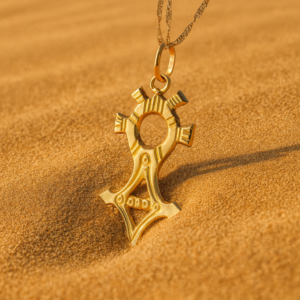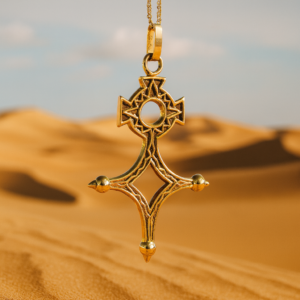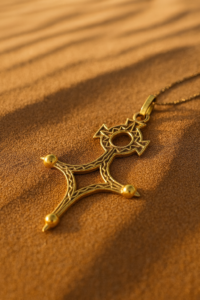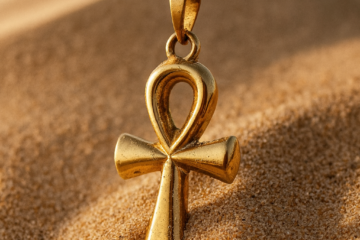At ÓNÍSÌ PARIS, we celebrate jewelry that tells the story of connection — between regions, histories, and hands. The Cross of the South, with its journey from the Saharan sands to the shores of the Mediterranean, perfectly embodies that spirit.
Each gold pendant we offer continues this lineage: a tribute to heritage, artistry, and the quiet dialogue between worlds that defines so much of vintage jewelry.
 The Cross of the South: From the Sahara to the Mediterranean
The Cross of the South: From the Sahara to the Mediterranean
Among the many symbolic pendants that grace the world of jewelry, few possess the quiet magnetism and layered history of the Cross of the South, also known as the Agadez Cross. Crafted with geometric precision and spiritual depth, this form reflects the centuries-old cultural dialogue between North Africa and the South of France — two worlds long connected by trade, travel, and artistry.
A Cross Born in Agadez
The origins of the Cross of the South reach deep into the Saharan region, particularly around the city of Agadez, in present-day Niger. There, among the Tuareg, a nomadic Berber people renowned for their silversmithing, this pendant — called tanaghilt or tasagalt — became an emblem of identity, protection, and family tradition. Each piece was traditionally cast in silver using the lost-wax technique and often given from father to son as a symbol of adulthood and blessing.
According to Tuareg tradition: “I give you the four directions of the world, because we do not know where you will go to die.”
Far from being a Christian symbol, the cross shape represents the four cardinal points, evoking freedom, movement, and the vast expanse of the desert sky.
From the Sahara to the South of France
Through centuries of contact — from medieval trade routes to colonial exchanges — the Cross of Agadez gradually made its way across the Mediterranean. Its balanced, architectural form and protective symbolism resonated deeply in Provence, Languedoc, and coastal southern France, where craftsmanship and faith often intertwined.
There, goldsmiths and travelers reinterpreted the design, crafting it in 18k gold and integrating it into regional jewelry traditions. The result was a new chapter in the life of this ancient motif: the Cross of the South, both familiar and exotic, bridging the worlds of Africa and Europe.
This blending of influences is what gives the piece its enduring charm — a reminder that jewelry has always been a vessel of exchange, carrying stories across borders and generations.
Symbolism That Transcends Borders
Whether worn in silver or gold, the Cross of the South remains a talisman of direction, protection, and identity. Its geometry — a balance of triangles, circles, and points — speaks to universality and harmony.
For many, it is a map of belonging: a reminder that art and meaning move freely, transcending geography. From Tuareg caravans to Provençal workshops, its form has adapted while preserving its soul — a symbol of shared heritage across the Mediterranean world.
The Cross of the South Today
Today, collectors and jewelry lovers are rediscovering the Cross of the South / Agadez Cross for its sculptural beauty and deep narrative. Whether rendered in silver as in Tuareg tradition, or in solid 18k gold as found in French regional jewelry, each pendant carries with it the weight of centuries and the grace of timeless design.
It is a piece that unites rather than divides — a luminous emblem of how cultures meet, merge, and endure through craftsmanship.
 en
en
 Français
Français




